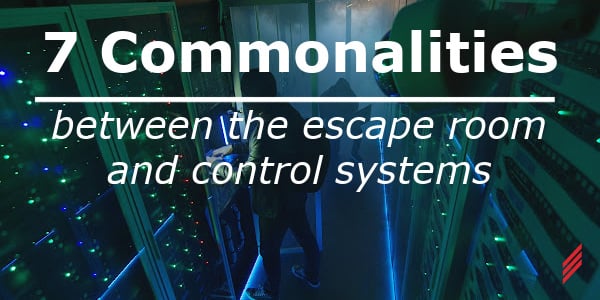7 Commonalities Between The Escape Room and Control Systems
by Dani Liu on Jul 14, 2022 10:30:00 AM

Like other twenty-somethings, I enjoy participating in a team building game called The Escape Room. It is a fun reality adventure where a group of participants get together to find clues and solve a series of puzzles in order to escape from a locked space in some given time.
As a system integrator, a year and a half deep into the automation waters, I found similarities between this game and the controls industry; and here I am to use this game as an analogy to share with you 7 things that I have learned from my experience.
1. Pay attention to the field survey, the environment is the best clue
The Game: Each escape room challenge is built upon a theme such as Treasure Island, Sherlock’s office or a prison trap depending on the game studios. Observing the environment based on the given theme is the best way to start making the right connections without wasting time on random distractions.
Controls: In order to start a project, we need to conduct a detailed field survey to see what we are working with and what we need to create. For new systems, it is not as critical, since the installation will be based on brand new P&IDs and loop sheet drawings and no production impact could occur. When it comes to improving existing systems, however, detailed field survey is extremely necessary for increasing project efficiency, avoiding production downtime and improving overall customer satisfaction. Items such as old/new panel location, existing control module models, I/O, communication modules, instrument location/specification, manufacturer and model numbers, original drawings, power supply location, existing programs and HMI software information are all useful to obtain from the field.
2. Prioritize the tasks and remember that one clue is built upon another
The Game: Crack the most obvious clue first and use that as the key to find the next one. If we had a Treasure Island themed challenge and there are wooden chests lying around, I would definitely start opening them to look for the hidden info.
Controls: After collecting all the useful information we can, the next step is to understand the project scope hierarchy and prioritize the tasks accordingly. For example, the panel design and construction could be one of the first items on the list to be started, which will pave the way to module installation, I/O wiring, programming and communications. The I/O wiring and the instrument configuration/testing could be done hand in hand to provide efficient quality assurance. Even though for the actual PLC programming, we tend to start from the smallest element and move up to equipment modules and phases, it is not a bad idea to consider designing the big structure of the program first to include all possible scenarios.
3. Listen to people, they might know something that you don’t
The Game: Occasionally, there could be more than one group of players in the escape room. Some are your friends, others might be strangers. Don’t forget to include everyone in the brainstorming session and utilize all the talents that you can. Each person could have their own unique set of skills and knowledge to contribute to solving the puzzle.
Controls: We all know that we need to listen carefully to our customers, but what about the people that we work with at the job site? The input from the electricians, plant operators, IT personnel and mechanics can be very useful during system troubleshooting.
I was at a chemical plant once, verifying the functionality of the solenoid valves. Halfway through the test, one of the status bits for the valves would not turn on. I checked the program, the wiring and the air supply several times, but could not find any issue that would have possibly contributed to the test failure. A little confused and frustrated, I described the problem to the electrician that we were working with and asked for some advice. He carefully took the valves apart, tweaked the inside and then said, ”all set, I have had this happen to me a few times in the past.” It turned out that the angle of the cam position inside was slightly off, so the status relay for the valve was not even being touched throughout the entire opening and closing motion. If it was not for the electrician, it could have cost me hours to figure that out. Having the opportunity to work with all kinds of experienced professionals is one of the best and cost effective ways for us to learn as system integrators.
4. Process of elimination is handy when we get stuck
The Game: Sometimes the clues can be confusing and lead to more than one interpretation by different players. It is often easier to stay calm and spend time focusing on one possibility at a time.
Controls: Communication issues between devices can be common in the startup process. We could configure two devices separately and confirm that they both work on their own, but when we bring them together, things start to go wrong or missing. In this situation, it is wise to start troubleshooting by making a list of components that might have contributed to the communication loss, and test each one of them separately to pinpoint the cause. More often than not, we will find that the problems are almost too simple to be true. They can be caused by anything from a loose cable, a blocked port, active firewall, or a missing jumper, so no repeat of complex calculations or configurations is even necessary.
5. Document, document, document
The Game: Sometimes the players will be given a notepad and a pen to keep track of the information they found and puzzles they solved. When possible, especially for the games with intense literary or number based clues, it is important to document the paths/directions already taken to prevent teammates from putting in redundant effort.
Controls: System integrators wear many hats and will be a part of the project design, installation, commissioning and programming. It is beneficial for us to document the work we do via Excel, emails, drawing redlines and pictures if permitted to help us stay on track. Even though most of the projects we get are continuous, there are occasions when they stall for a while, and we are expected to pick them back up sometime in the future. Or just as we think we are done with our scope, the customer comes up with a crucial design change to the system, we need to trace back to the documents to assess the feasibility of the change, the additional amount of controls work required and the potential risks to the already running system. Having the appropriate documentation will allow us to seamlessly pick up where we left off.
6. Use help when needed
The Game: Hints can be given at the sacrifice of 10% game time for each piece of useful information. It is a good idea to use one or two when the team is really stuck to bring everyone back on track.
Controls: The controls industry has so many ins and outs and we are not going to have time to research every single case while working on projects. It is highly likely that someone somewhere had to deal with the same issue that we are facing. Reinventing the wheel will significantly reduce project efficiency and cause a missed relationship building opportunity with talented individuals.
I have learned a significant amount from the resources available in my experience with Hallam-ICS including technical support, instrument sales representatives, system integrators from other offices, IT, subcontractors and even customers. For example, the technical support service from Rockwell Automation has been extremely beneficial to me, especially when I first started learning the FactoryTalk Historian configuration. I called Rockwell so often that the two representatives I spoke to both knew my name and cases by heart. We even made a joint conference call with OSIsoft to learn together when new problems came up that were not explored before. It is amazing how much people are willing to help, as long as you are willing to ask for it.
7. Have fun and don’t sweat too much!
The Game: No matter if we successfully unlock the room in time or have to officially “give up” and ask for the final release from the game studio operators, it has always been a good bonding time.
Controls: Every project is a journey. There are ups and downs within it and we will never see the full picture until we get to the end. The happiest moments occur when a problem that has been blocking the road for way too long finally gets resolved; the frustrating times happen when everything seems to have been correctly put together, but the system just does not work 100% for some unknown reason.
After all, like my manager said, we are going to learn something for sure.
About the author
Dani has left Hallam-ICS to pursue other endeavors, but her contributions to the company continue to be valued.
About Hallam-ICS
Hallam-ICS is an engineering and automation company that designs MEP systems for facilities and plants, engineers control and automation solutions, and ensures safety and regulatory compliance through arc flash studies, commissioning, and validation. Our offices are located in Massachusetts, Connecticut, New York, Vermont and North Carolina and our projects take us world-wide.
You May Also Like
These Related Stories

Three Common Misconceptions that are Costing You Money-Part 2

The First 2 Steps to Complete your TGMS Safety Requirement Specification


No Comments Yet
Let us know what you think